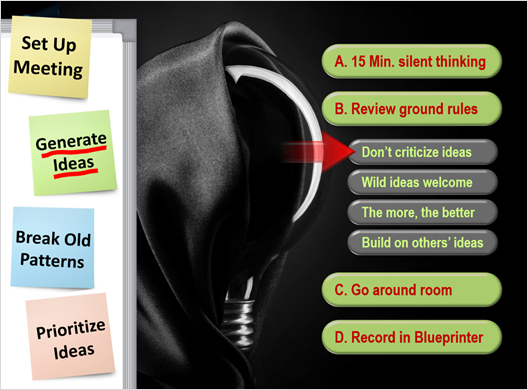- BLUE HELP
- Rest of Blueprinting (Steps 4-7)
- Blueprinting Step 6: Technical Brainstorming
-
Blueprinting Center & Methodology
- What is New Product Blueprinting?
- How is Blueprinting learned and applied?
- Blueprinting Center
- Blueprinting E-Learning Course
- How can I become Certified in New Product Blueprinting?
- How does Blueprinting fit with a stage-and-gate process?
- How does Blueprinting fit with strategic planning?
- How does Blueprinting fit with Design Thinking?
- How does Blueprinting fit with Lean Startup?
- How does Blueprinting fit with Minesweeper de-risking?
- How does Blueprinting fit with LaunchStar product launch?
- What innovation metrics should we use?
- What is "Jobs-to-be-Done?"
-
Blueprinter® Software
-
Market Segmentation (Step 1)
-
Discovery Interviews (Step 2)
- How to plan Discovery interviews
- Preparing your interview team
- Convincing customers to be interviewed
- How to handle confidential info in an interview
- How to conduct a Discovery interview
- Finding & using a digital projector for interviews
- How to conduct a customer tour
- How to debrief & follow-up a Discovery interview
- Engaging your sales colleagues in interviews
- Engaging distributors in interviews
- Interviewing customers down the value chain
- How to interview remotely with web-conferences
- How to interview at trade shows & other venues
- Interviewing in different global cultures & languages
- How to listen well during customer interviews
- How to probe during customer interviews
- How to gather economic data during interviews
- How to create & use Current State questions
- How to identify Must Haves (MH)
- How to select Top Picks (TP)
- How to use Trigger Maps
- How to form Outcome Statements
-
Preference Interviews (Step 3)
-
Rest of Blueprinting (Steps 4-7)
-
Everyday VOC
-
Minesweeper® De-risking
3. Brainstorming Step 2: Generate ideas
This is the "heart" of brainstorming. Here are tips for best results.
The second step is to generate ideas… lots of them. Start by giving everyone 15 minutes of silent thinking time. You may not have done this before, but it lets everyone follow their own unique course of thinking before being influenced by others.
Then review Osborn’s ground rules… Don’t criticize ideas… wild ideas are welcome… the more, the better… and build on each other’s ideas. The 1st rule is hard for some to follow… so watch for and discourage any violations. You don’t want a “Grim Idea Reaper” shutting down the free flow of ideas.
Then go around the room, asking for one idea per person… and record them in Blueprinter software. This also may be new for you: In many brainstorming sessions, people just shout out their ideas as they occur to them. But since you had the silent idea generation first, each person probably has a list ready. Going around the room getting one idea at a time has these benefits:
- It doesn’t allow one person to dominate the discussion.
- It gives incentive for everyone to think of more ideas… so they’re not the first to “run out.”
Encourage people to springboard off others’ ideas, adding more ideas to their own list. Keep going around the room until no one can think of any more ideas. Record their ideas on a Brainstorm Sheet in Excel-based Blueprinter 4.0 (accessible by clicking the Brainstorm Sheet link in Step 6.

For more on this topic, see e-Learning Module 29: Technical Brainstorming at www.blueprintintcenter.com > e-Learning.
Keywords: Blueprinting Step 6: Technical Brainstorming, solution brainstorming, solution ideation, technology development, product development, science-facing, market-facing, generate ideas, generate solutions, don't criticize ideas, wild ideas welcome, the more ideas the better, build on others' ideas,
